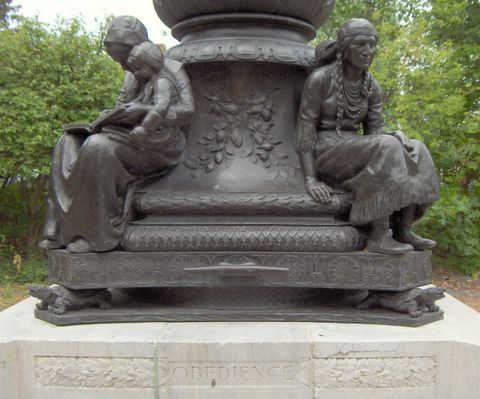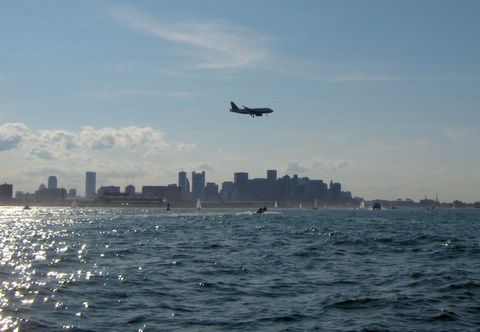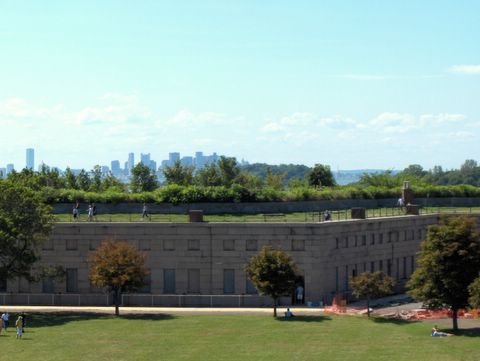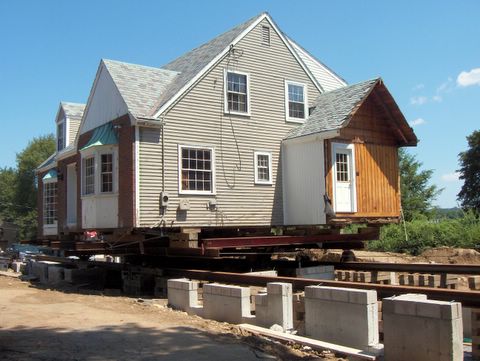
In the gardens of the Arlington’s town hall, the Robbins Memorial Flagstaff exhibits on its pedestal four bronze seated figures symbolizing Patriotism, Liberty, Obedience, and Honor. Before the pilgrims arrived in New England, the Boston area was inhabited by Indian tribes. Squaw Sachem sold her land to the colonist John Winthrop for few shillings and a woolen coat every winter for the rest of her life. Represented on the left is the mother pilgrim, and on the right is Squaw Sachem.
Dans les jardins de la mairie d’Arlington, le piédestal du Robbins Memorial Flagstaff représente quatre statues assises symbolisant le Patriotisme, la Liberté, l’Obéissance et l’Honneur. Avant que les pilgrims ne s’installent en Nouvelle Angleterre, la région de Boston était habitée par des tribus indiennes. Squaw Sachem vendit ses terres au colon John Winthrop pour quelques shillings et en échange d’un manteau de laine fourni tous les hivers jusqu’à sa mort.
Aug 27, 2006
A land for a woolen coat
Posted by
Alex
at
8:41 PM
4
comments/commentaires
![]()
![]()
Aug 20, 2006
Fasten your seat belts!

This plane is about to land at Logan International Airport, located almost in the center of Boston. Logan has a record of being one of the 20 busiest airports in the United States, with well over 27 million passengers each year. The airport was named after general Edward Lawrence Logan who fought during World War I in France. When landing, the passengers have a wonderful view of Boston’s skyline, featured in the background of this photo.
Cet avion va bientôt atterrir à l’aéroport international Logan situé presque au centre de Boston. Logan est un des 20 aéroports qui ont le plus de trafic aux Etats-Unis, avec plus de 27 millions de passagers par an. L’aéroport tient son nom du général Edward Lawrence Logan qui a combattu en France durant la première guerre mondiale. A l’atterrissage, les passagers ont une très belle vue sur Boston, que l’on aperçoit à l'arrière plan.
Posted by
Alex
at
5:19 PM
12
comments/commentaires
![]()
![]()
Aug 13, 2006
Defending the city

In the 18th Century, Boston was the largest seaport in America. To defend the city from attacks during the Civil War, Fort Warren was built in 1833 on Georges Island (off the coast of Boston harbor). This massive pentagonal-shaped granite fortification with tower-bastions at the corners follows the 17th century design of French military engineer Sébastien de Vauban. I took this picture from the interior parade ground. The Boston skyline appears in the far background.
Au 18ème siècle, Boston était le plus grand port maritime d'Amérique. Pour défendre la ville des attaques durant la Guerre de Sécession, le Fort Warren fut construit en 1833 sur Georges Island (au large du port de Boston). Cette fortification massive de granite en forme de pentagone avec des tours de garde à chaque coin suit les plans du 17ème siècle de l'ingénieur militaire français Sébastien de Vauban. J'ai pris cette photo de la cour intérieure du fort. La silhouette de Boston se dessine au fond à l'horizon.
Posted by
Alex
at
11:15 PM
3
comments/commentaires
![]()
![]()
Aug 6, 2006
Jack it up!

If you don’t like where your house stands, well, jack it up, and move it! These homeowners have decided to find a new location for their home. It is indeed easy to move traditional American houses because they are mostly built with wood material. This one doesn’t go very far, only 50 yards away, but sometimes they travel through the streets.
Si vous n’aimez pas où l'endroit se trouve votre maison, eh bien, soulevez la sur des vérins et déplacez la. Ces propriétaires ont décidé de trouver un nouvel emplacement pour leur maison. Il est facile, en effet, de déplacer les maisons américaines traditionnelles car elles sont pour la majorité construites en bois. Celle-ci n’ira pas très loin, seulement à 50 mètres, mais parfois les maisons sont transportées d’un bout à l’autre de la ville.
Posted by
Alex
at
9:29 PM
9
comments/commentaires
![]()
![]()

